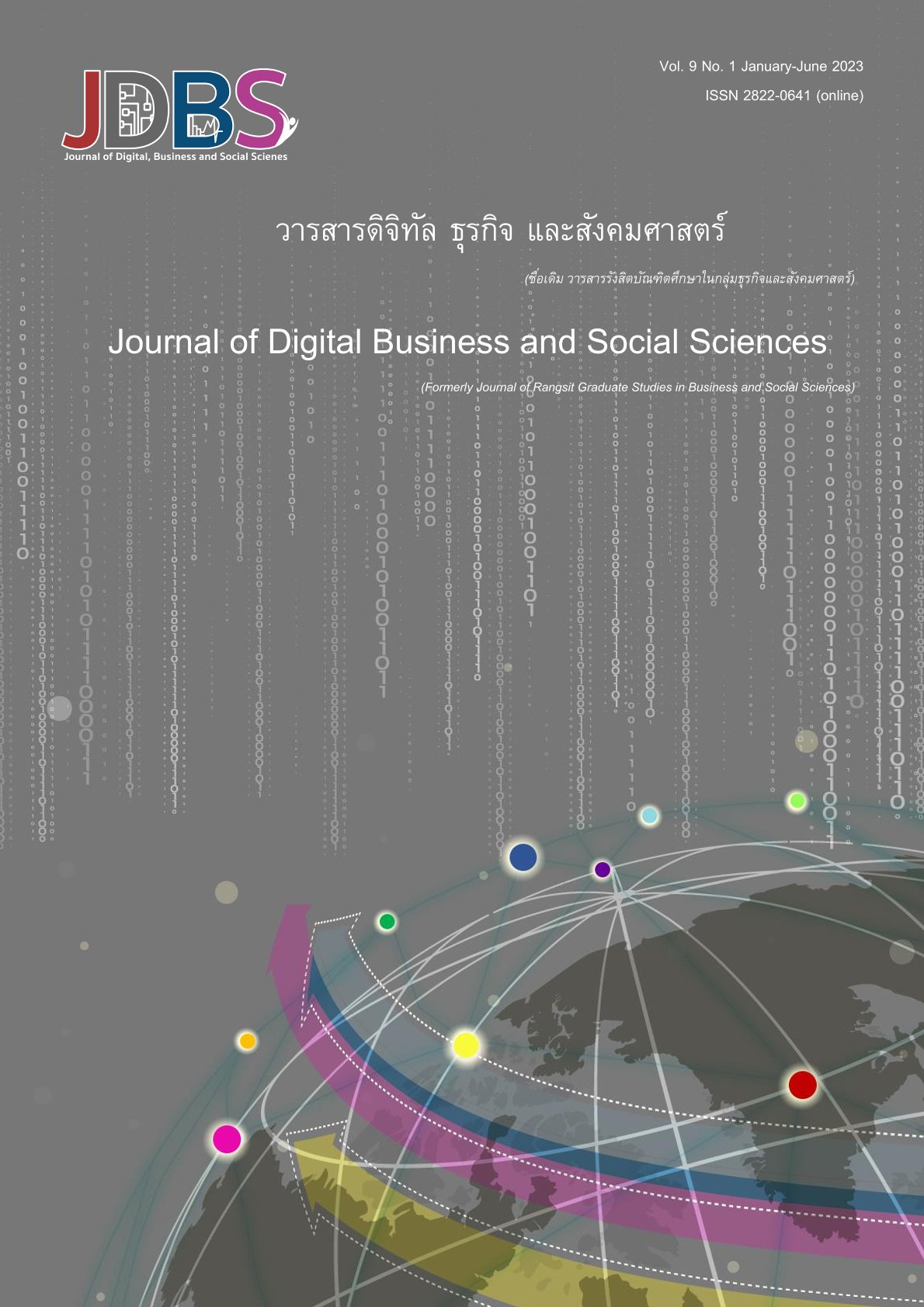Model of the Development of Competence of Entrepreneurs in the Automobile Parts Manufacturing Industry
Abstract
This study set 3 research objectives: (1) to study and analyze the competence of entrepreneurs in the auto parts manufacturing sector. Auto parts manufacturing industry, (2) to study the success that affects the performance of entrepreneurs in the auto parts manufacturing sector, and (3) to study the feasibility of developing the competence of entrepreneurs in the auto parts manufacturing sector. The auto parts manufacturing industry uses a qualitative research methodology from the sample group of key informants. There are four groups: owners, entrepreneurs, executives, academics, and those involved in developing the competence of entrepreneurs in the auto parts manufacturing industry. in industrial area Samut Prakan Province. A total of 18 people were sampled.
The results of the research revealed that the model for developing the competency of entrepreneurs in the automotive parts manufacturing sector in the present era is a four-core competency approach consisting of (1) manufacturer competency, (2) production process competency, (3) personnel competency; and (4) marketing and communication competency.
References
กระทรวงอุตสาหกรรม. (2561). สภาอุตสาหกรรมยานยนต์ไทย กลุ่มอุตสาหกรรมยานยนต์สภาอุตสาหกรรมแห่งประเทศไทย. สืบค้นจาก http://data.thaiauto.or.th/iu
กรมพัฒนาฝีมือแรงงาน. (2559). รายงานการดำเนินงานประจำปีงบประมาณ 2559 และมอบนโยบายการทำงานตามยุทธศาสตร์ 20 ปี. สืบค้นจาก http://www.dsd.go.th/DSD/Activity/ShowDetails/23475
กรมส่งเสริมอุตสาหกรรม. (2561). ฐานข้อมูลอุตสาหกรรมชิ้นส่วนยานยนต์. สืบค้นจาก http://www.fti.or.th
กรมส่งเสริมอุตสาหกรรม. (2565). ฐานข้อมูลอุตสาหกรรมชิ้นส่วนยานยนต์. สืบค้นจาก http://www.fti.or.th/FTI%20Project/GroupCall.aspx
ชาย โพธิสิตา (2556). ศาสตร์และศิลป์แห่งการวิจัยเชิงคุณภาพ. กรุงเทพฯ: อมรินทร์พริ้นติ้ง.
ฐนกร บุญจันทร์. (2560). รูปแบบภาวะผู้นําของหัวหน้าฝ่ายผลิตในอุตสาหกรรมยานยนต์. วิทยานิพนธ์ดุษฎีบัณฑิต.
มหาวิทยาลัยเทคโนโลยีพระจอมเกล้าพระนครเหนือ.
เทื้อน ทองแก้ว. (2552). สมรรถนะ (Competency): หลักการและแนวปฏิบัติ. กรุงเทพฯ: มหาวิทยาลัยราชภัฏสวนดุสิต.
ไทยพับลิก้า. (2564). จำนวนโรงงานอุตสาหกรรมจังหวัดสมุทรปราการ. สืบค้นจาก https://thaipublica.org/2021/07/concentration-of-industrial-factories-in-samutprakarn/
บริษัท อินโฟเควสท์ จำกัด. (2561). มติคณะรัฐมนตรีเรื่องยุทธศาสตร์การพัฒนากำลังแรงงานในอุตสาหกรรมยานยนต์และชิ้นส่วนอะไหล่ยานยนต์. สืบค้นจาก https://www.ryt9.com/s/cabt/1727812
วาสนา ศรีอัครลาภ, และจิราวรรณ คงคล้าย. (2559). การบริหารทรัพยากรมนุษย์ในองค์การแห่งยุคสารสนเทศสู่องค์การยุคใหม่ในอนาคต. วารสารฉบับภาษาไทย สาขามนุษยศาสตร์ สังคมศาสตร์และศิลปะ มหาวิทยาลัยศิลปากร, 9(2), 328-338.
ศูนย์วิจัยกสิกรไทย. (2556). สถานการณ์ ตลาดแรงงานไทยในเอเชีย. Econ Analysis, 19(2433), 1-6.
สถาบันยานยนต์ ศูนย์สารสนเทศยานยนต์. (2553). อุตสาหกรรมยานยนต์. สืบค้นจาก http://www.thaiauto.or.th/2012/th
สถาบันยานยนต์ ศูนย์สารสนเทศยานยนต์. (2561). สถิติยานยนต์ไทย. สืบค้นจาก http://data.thaiauto.or.th
สภาอุตสาหกรรมแห่งประเทศไทย. (2561ก). สถิติการผลิตการจำหน่ายและส่งออกของอุตสาหกรรมยานยนต์ไทย. สืบค้นจาก https://www.fti.or.th
สภาอุตสาหกรรมแห่งประเทศไทย. (2561ข). สถิติอุตสาหกรรมชิ้นส่วนและยานยนต์. สืบค้นจาก http://www.fti.or.th/2016/thai/ftitechnicalsubdetail
สมาคมวิศวกรรมยานยนต์ไทย. (2560). ศักยภาพที่แท้จริงของอุตสาหกรรมยานยนต์ไทย. กรุงเทพฯ: ผู้แต่ง.
สมาคมอุตสาหกรรมยานยนต์ไทย. (2557). สถิติอุตสาหกรรมยานยนต์ไทย. สืบค้นจาก http://www.taia.or.th/Statistics/
สำนักงานสถิติแห่งชาติ. (2555). อุตสาหกรรมยานยนต์ไทย. สืบค้นจาก http://service.nso.go.th/nso/nsopublish/census/files/2012_Automotive.pdf
สำนักงานส่งเสริมวิสาหกิจขนาดกลางและขนาดย่อม. (2561). สรุปสถานการณ์อุตสาหกรรมชิ้นส่วนยานยนต์ของ SMEs ไทย. สืบค้นจาก http://www.sme.go.th/th/images/data/SR/
Abdullah, A. M., Persna, S., Noorshella, B. C. N., & Raihani, B. Z. (2016). Entrepreneurial competencies and microenterprise performance: A study among informal micro-enterprises in Malaysia. Journal of Social sciences, 5(3), 5-11.
Botha, M., Vuuren, J., & Kunene, T. (2015). An integrated entrepreneurial performance model focusing on the importance and proficiency of competencies for start-up and established SMEs. South African Journal of Business Management, 46, 55-66.
Jaeger, R. M. (Ed.). (1997). Complementary Methods for Research in Education (2nd ed.). Washington, DC: American Educational Research Association.
Karden, E., Ploumen, S., Fricke, B., Miller, T., & Snyder, K. (2007). Energy Storage Devices for Future Hybrid Electric Vehicle. Journal of Power Source, 168(1), 2-11.
Kuratko, D. F., & Hodgetts, R. M. (2007). Entrepreneurship: A Contemporary Approach. Orlando: Harcourt Brace College Publishers.
Lans, T., Blok, V., & Wesselink, R. (2014). Learning apart and together: towards an integrated competence framework for sustainable entrepreneurship in higher education. Journal of Cleaner Production, 62, 37-47.
Man, T. W. Y., Lau, T., & Snape, E. (2008). Entrepreneurial competencies and the performance of small and
medium enterprises: An investigation through a framework of competitiveness. Journal of Small Business & Entrepreneurship, 21(3), 257-276.
McClelland, D. C. (1973). Testing for competence rather than for “intelligence”. American Psychologist, 28(1), 1-4.
McMillan, J. H. (2000). Educational Research: Fundamentals for the Consumer. New York: Addison Wesley Longman Inc.
Mitchelmore, S., & Rowley, J. (2013). Entrepreneurial competencies of women entrepreneurs pursuing business growth. Journal of Small Business and Enterprise Development, 20(1), 125-142.
Northouse, P. G. (2013). Leadership: Theory and practice (6th ed.). Thousand Oaks, CA: Sage Publications, Inc.
O'Hagan, K. (1996). Competence in social work practice: A practical guide for professionals. London: Jessica Kingsley Publishers.
Ozcelik, G., & Ferman, M. (2006). Competency approach to human resources management: Outcomes and contributions in a Turkish cultural context. Human Resources Development Review, 5(1), 72-91.
Peter F. R. (1994). Electric Machinery. USA: Prentice-Hall, Inc.
Pepple, G. J., & Enuoh, R. O. (2020). Entrepreneurial Competencies: A Required Skill for Business Performance. European Journal of Business and Innovation Research, 8(3), 50–61.
Phelan, C., & Sharpley, R. (2012). Exploring entrepreneurial skills and competencies in farm tourism, Local Economy. The Journal of the Local Economy Policy Unit, 27(2), 103-118.
Photchanachan, S., Uppapong, K., Atchavanan, C., Mangkang, K., & Kanwivat, S. (2020). The Characteristics
of Social Entrepreneurs in Thailand. Journal of Humanities and Social Sciences, Rajapruk University, 6(3), 31-43.
Siddiqi, T. A. (2008, July). Asia’s Growing Emission of Carbon Dioxide from Energy Use. The International Energy Workshop (IEW), The Economic Analysis Division of the International Energy Agency, Paris.
Stake, R. E. (1988). Case Study Methods in Educational Research: Seeking Sweet Water. In R. M. Jaeger (Ed.), Complementary Methods for Research in Education (pp. 253-300). Washington DC: American Educational Research Association.
Strauss, A., & Corbin, J. (1998). Basics of qualitative research: Techniques and procedures for developing grounded theory (2nd ed.). Thousand Oaks, CA: Sage Publications, Inc.
Teece, D. J. (2012). Dynamic capabilities: Routines versus entrepreneurial action. Journal of Management Studies, 49(8), 1395-1401.


